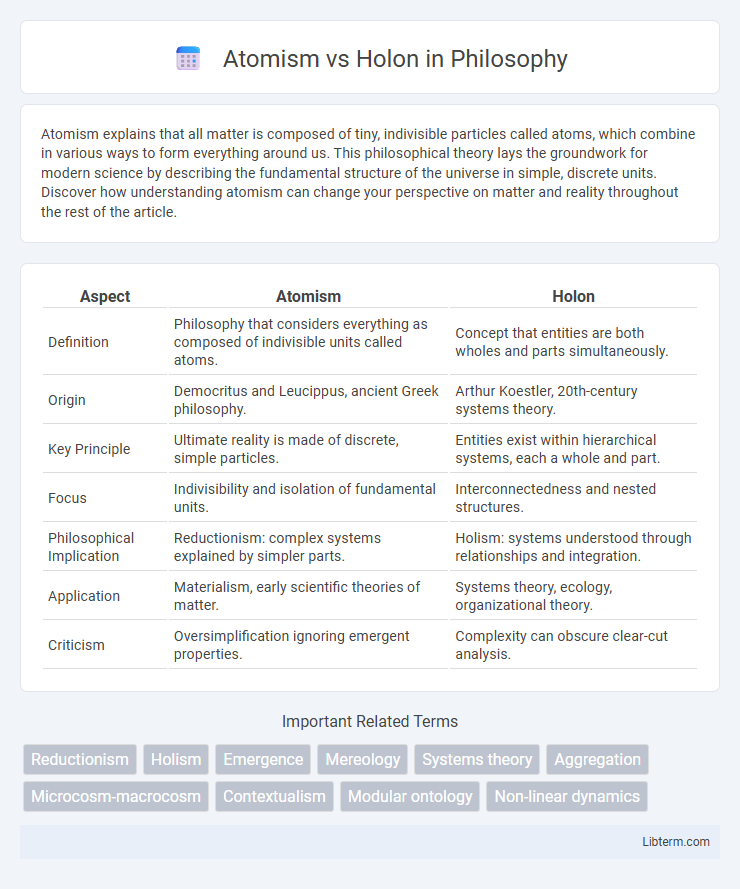Atomism explains that all matter is composed of tiny, indivisible particles called atoms, which combine in various ways to form everything around us. This philosophical theory lays the groundwork for modern science by describing the fundamental structure of the universe in simple, discrete units. Discover how understanding atomism can change your perspective on matter and reality throughout the rest of the article.
Table of Comparison
| Aspect | Atomism | Holon |
|---|---|---|
| Definition | Philosophy that considers everything as composed of indivisible units called atoms. | Concept that entities are both wholes and parts simultaneously. |
| Origin | Democritus and Leucippus, ancient Greek philosophy. | Arthur Koestler, 20th-century systems theory. |
| Key Principle | Ultimate reality is made of discrete, simple particles. | Entities exist within hierarchical systems, each a whole and part. |
| Focus | Indivisibility and isolation of fundamental units. | Interconnectedness and nested structures. |
| Philosophical Implication | Reductionism: complex systems explained by simpler parts. | Holism: systems understood through relationships and integration. |
| Application | Materialism, early scientific theories of matter. | Systems theory, ecology, organizational theory. |
| Criticism | Oversimplification ignoring emergent properties. | Complexity can obscure clear-cut analysis. |
Introduction to Atomism and Holon
Atomism, a philosophical doctrine originating in ancient Greece, posits that all matter is composed of indivisible, discrete units called atoms, emphasizing reductionism and the fundamental building blocks of reality. Holon, a concept introduced by Arthur Koestler, refers to entities that are simultaneously wholes and parts within a hierarchical system, highlighting the interdependence and nested complexity of structures. The contrast between Atomism and Holon lies in Atomism's focus on isolated, fundamental units versus Holon's emphasis on integrated, multi-level organization.
Historical Origins of Atomistic Thought
Ancient Greek philosophers such as Leucippus and Democritus pioneered atomistic thought by proposing that the universe is composed of indivisible units called atoms, which form the fundamental building blocks of matter. This early atomism contrasted with holistic concepts that view systems as integrated wholes rather than mere aggregates of parts. The atomistic framework laid the groundwork for modern scientific approaches by emphasizing discrete, separate components as the basis for understanding physical reality.
Emergence of Holistic Perspectives
Atomism emphasizes analyzing systems by breaking them into fundamental, indivisible units, often missing the complex interactions that define whole entities. Holon theory introduces the concept of parts as both autonomous wholes and integral components, highlighting multi-level structures within systems. The emergence of holistic perspectives underscores the significance of relationships and interactions, revealing properties and behaviors that cannot be understood through isolated analysis alone.
Fundamental Principles of Atomism
Atomism is based on the fundamental principle that the universe is composed of indivisible, discrete particles called atoms, which combine in various ways to form all matter. These atoms are indivisible, indestructible, and eternal, possessing inherent properties that determine physical phenomena through their arrangement and motion. This principle emphasizes reductionism, where understanding the whole requires analyzing its smallest constituent parts independently.
Core Concepts of Holon Theory
Holon Theory centers on the concept that every entity simultaneously exists as a whole and a part within a larger system, emphasizing nested hierarchies and relational interdependence. Unlike Atomism, which breaks down systems into indivisible, discrete units, Holon Theory views units as dynamic and autonomous yet integrated within broader contexts. This approach highlights the importance of synergy and multi-level interactions for understanding complex systems in fields such as ecology, organizational theory, and cognitive science.
Atomism vs. Holon: Key Differences
Atomism emphasizes understanding complex systems by breaking them down into their smallest, indivisible parts known as atoms. In contrast, Holon theory recognizes entities as both wholes and parts, integrating hierarchical layers where each holon functions autonomously yet remains embedded within a larger system. Key differences include atomism's reductionist perspective versus holon's emphasis on interconnectedness and multi-level organization.
Applications in Science and Philosophy
Atomism, emphasizing discrete, indivisible units as the foundation of matter, informs scientific fields like particle physics and chemistry by analyzing fundamental particles and their interactions. Holon theory, highlighting entities as both wholes and parts, influences systems biology and ecology by addressing complex, hierarchical structures and emergent properties within organisms and ecosystems. Philosophically, atomism aligns with reductionism, while holon theory supports integrative approaches, framing reality as interconnected layers rather than isolated components.
Atomism and Holons in Modern Systems Thinking
Atomism in modern systems thinking emphasizes analyzing complex systems by breaking them down into fundamental, independent units called atoms, enabling detailed examination of each component's properties. Holons, conversely, represent entities that are simultaneously wholes and parts of larger systems, capturing the nested, hierarchical nature of reality and fostering integrated system perspectives. Understanding these paradigms elucidates how atomistic reductionism contrasts with holistic integration, informing approaches in fields like organizational theory, ecology, and artificial intelligence.
Criticisms and Limitations of Both Approaches
Atomism faces criticism for its reductionist view, often oversimplifying complex systems by isolating individual parts without acknowledging their interconnectedness. Holon theory, while emphasizing the nested and integrative nature of components within wholes, can be criticized for conceptual vagueness and difficulties in empirical validation due to its abstract hierarchical framework. Both approaches encounter limitations in addressing dynamic, context-dependent interactions that challenge rigid categorizations and require more flexible, multi-dimensional models.
Future Directions: Integrating Atomism and Holon
Future directions in philosophy and science emphasize integrating atomism and holon theories to create a comprehensive framework that accounts for both discrete elements and their hierarchical organizations. This integration supports advancements in complex systems modeling, enabling more accurate representations of emergent properties in fields like biology, artificial intelligence, and social sciences. Emerging research focuses on developing hybrid methodologies that leverage the strengths of atomistic precision and holonic context to enhance predictive capabilities and system interventions.
Atomism Infographic

 libterm.com
libterm.com